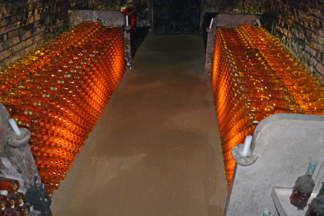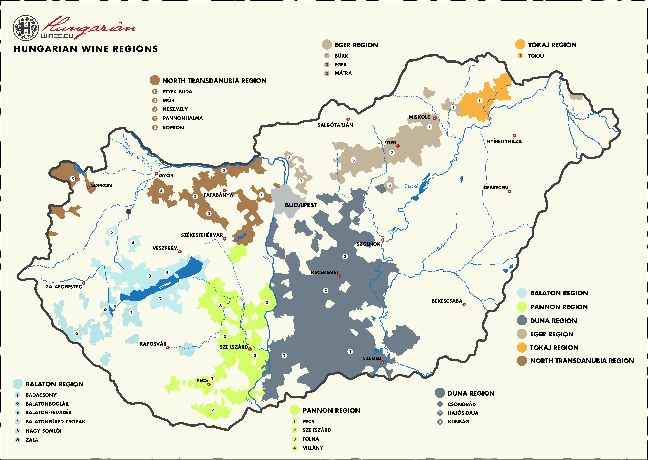Hungary
Hungarian Wine History
 Hungarian winemaking techniques can be traced from Central Asia, the Caucasus region and the Romans. Ultimately there was a blend of winemaking styles over the centuries that shaped winemaking in Hungary. Winemaking styles that influenced winemaking practices were from Benedictine missionaries, other teaching orders, Italian, Anjou, Rhine Valley and Burgundy winemakers.
Hungarian winemaking techniques can be traced from Central Asia, the Caucasus region and the Romans. Ultimately there was a blend of winemaking styles over the centuries that shaped winemaking in Hungary. Winemaking styles that influenced winemaking practices were from Benedictine missionaries, other teaching orders, Italian, Anjou, Rhine Valley and Burgundy winemakers.
According to the Hungarian Consulate in New York, early archaeological finds have wine and grapes dating to the 1st century BC. There is data showing that the region has been growing grapevines and making wine since Roman times.
Some Important Wine Dates
| 1235 to 1270 | Bela IV made winemaking a priority |
| 1541 to 1699 | Winemaking continued but not prolifically. |
| 1552 | The Eger regional legend surrounding the “Bull’s Blood” wine was tied to the 1552 siege of Eger. |
| By 1700 | Tokaj was the first vineyard classification established to emphasize quality. For 173 vineyards, Prince Rákóczi established a system of classification. |
| 1836 | The first Hungarian wine journal was written. The year was also important because of a committee established to “hinder adulteration.” |
| 1870s | Phylloxera began destroying the vineyards. |
| By 1892 | Taxes were implemented for wine consumption, although grape growers were provided with tax benefits. The Hillside Village Act was approved to improve the protection of appellation |
| 1896 | Hungary’s first viticulture research institute was established. |
| Late 1930s until 1948 | Wine production grew quickly. Under the Soviet dictatorship the wine industry was encouraged to produce quantities of wine rather than quality wine. |
| 1969 | State farms and cooperatives were able to develop the Hungarian wine production. |
| 1990 to 1994 | A new Hungarian wine era began with privatization. |
Grape Varieties
Hungary has several international varietal grapes. Some of these include the white grapes: Chardonnay, the Muscat family of grapes and Sauvignon Blanc. For international red grape varieties, there are plantings of Cabernet Franc and Cabernet Sauvignon. In addition to the international grape varieties, there are unique grapes to Hungary.
Unique White Grape Varieties
| Grape Variety | Region | Also Known As |
| Budai Zöld | Etyek | |
| Cserszegi Fűszeres | Throughout Hungary except Tokaj | |
| Ezerjó | Mór | |
| Furmint | Tokaj | |
| Generosa | Kunság, Hajós–Baja and Mór | |
| Hárslevelű | Tokaj | |
| Irsai Olivér | Balaton, Etyek | |
| Juhfark | Somló | |
| Kabar | Tokaj | |
| Kéknyelű | Badacsony, Balaton | |
| Királyleányka | Throughout Hungary | |
| Muscat Lunel or Yellow Muscat | Tokaj | Muscat Blanc à Petits Grains |
| Muscat Ottonel | Mátra, Eger, Kunság, Balaton | Ottonel Muskotály |
| Olaszrizling | Balaton, Eger and throughout Hungary | Graševina, Welschriesling |
| Szürkebarát | Mátra |
Unique Red Grape Varieties
| Grape Variety | Region | Also Known As |
| Kadarka | Eger, Szekszárd and throughout Hungary | |
| Kékfrankos | Eger, Szekszárd | Blaufränkisch (Austria), Lemberger (Germany) |
| Portugieser | Villány | Kékoportó |
Wine Regions
Hungary is divided into six wine regions and 22 sub-regions within the six larger regions. Sub-regions marked with an * were visited in march 2019.
| Large Region | Sub-Region |
| Tokaj | Tokaj* |
| Eger | Bükkalja Eger* Mátra |
| North Transdanubia Region | Etyek-Buda* Mór Ászár-Neszmély Pannonhalma* Sopron |
| Balaton Region | Badacsony* Balatonboglár* Balaton-Felvidék* Balatonfüred-Csopak* Somló* Zala |
| Pannon Region | Pécs Szekszárd* Tolna Villány* |
| Duna Region | Csongrád Hajós-Baja Kunság |

Map courtesy of hungarianwines.eu
